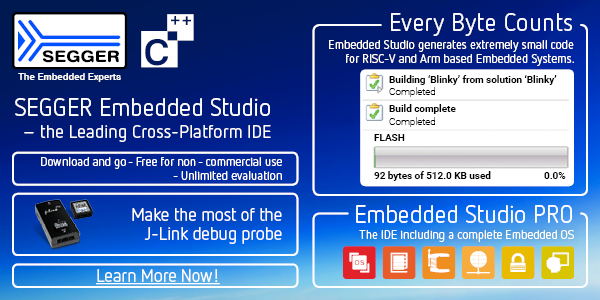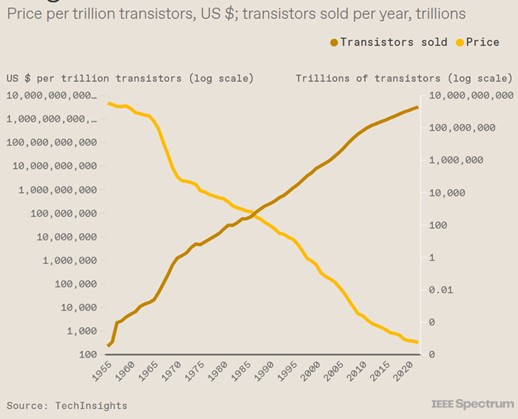|
||||||||||
You may redistribute this newsletter for non-commercial purposes. For commercial use contact jack@ganssle.com. To subscribe or unsubscribe go here or drop Jack an email. |
||||||||||
| Contents | ||||||||||
| Editor's Notes | ||||||||||
|
Tip for sending me email: My email filters are super aggressive and I no longer look at the spam mailbox. If you include the phrase "embedded muse" in the subject line your email will wend its weighty way to me. |
||||||||||
| Quotes and Thoughts | ||||||||||
“When you’re talking to Batman on ‘The Tonight Show,’ you’re not really talking to Batman. When you’re talking to an engineer, you’re talking to a real engineer.” Jay Leno |
||||||||||
| Tools and Tips | ||||||||||
|
Please submit clever ideas or thoughts about tools, techniques and resources you love or hate. Here are the tool reviews submitted in the past. Matthew Eshleman sent his test for the quality of a development team. It's a lot like the Joel Test:
Bertol Lekuona recommended a tool:
|
||||||||||
| Around the Web | ||||||||||
Here are a few tidbits I've run into on the Web this week. A short but fascinating article in IEEE Spectrum is worth your time. It shows, among other interesting facts, how the cost per trillion transistors has declined to the hundred-dollar level. As an old-timer who remembers when transistors cost money this blows my mind. A trillion of anything is a lot. I did a little calculation: 1 trillion grains of sand weighs 4 million kg. That's 200,000 twenty-five KG bags, which, at Home Depot prices, is over a million dollars... and transistors are made from sand. Pretty amazing. Here's a quote from that IEEE article: "According to TechInsight’s forecast, the semiconductor industry is on track to produce almost 2 billion trillion (1021) devices this year. That’s more transistors than were cumulatively made in all the years prior to 2017." Steve Leibson always writes interesting articles, and his (so far) two-part series about early microcontrollers is fascinating. Part 1 and part 2. I'm beginning to despair about security issues in the embedded space; there are lots of threats, broad attack surfaces, and not a lot of interest on the part of management to proactively address the problem. In fact, management seems determined to build systems that snoop - see the latest Risk Forum posting for notes on how tax companies send your info to Facebook (and who knows how many others), how airports are designed to track us, and much more. Anyway, here's a worthwhile article about building secure systems, but it is a bit lacking in applying known good practices prior to writing the code. While the article's focus on test is indeed important, we'll never get secure or safe systems via testing alone. How do waterfall and agile compare in terms of implementing unneeded features? One analysis suggests they are about equally bad, though combining the two can net worthwhile results. While I'm a bit skeptical about some of the assumptions used, the article is interesting. |
||||||||||
| Responses to "Give This to Your Boss" | ||||||||||
The article in the last Muse generated a fair number of emails. David Strip writes:
John Carter suggested:
Vlad Z faults Harvard Business:
From Greg Bollendonk:
Larry Marks looks at this from the hardware side:
|
||||||||||
| Failure of the Week | ||||||||||
From Steven Wheeler: From Jonathan: Have you submitted a Failure of the Week? I'm getting a ton of these and yours was added to the queue. |
||||||||||
| Jobs! | ||||||||||
Let me know if you’re hiring embedded engineers. No recruiters please, and I reserve the right to edit ads to fit the format and intent of this newsletter. Please keep it to 100 words. There is no charge for a job ad.
|
||||||||||
| Joke For The Week | ||||||||||
These jokes are archived here. A physicist, a biologist, and a chemist were going to the ocean for the first time. The physicist saw the ocean and was fascinated by the waves. He said he wanted to do some research on the fluid dynamics of the waves and walked into the ocean. He drowned and never returned. The biologist said he wanted to do research on the flora and fauna inside the ocean and walked inside the ocean. He, too, never returned. The chemist waited for a long time and afterwards, wrote the observation, "The physicist and the biologist are soluble in ocean water." |
||||||||||
| About The Embedded Muse | ||||||||||
The Embedded Muse is Jack Ganssle's newsletter. Send complaints, comments, and contributions to me at jack@ganssle.com. The Embedded Muse is supported by The Ganssle Group, whose mission is to help embedded folks get better products to market faster. |








